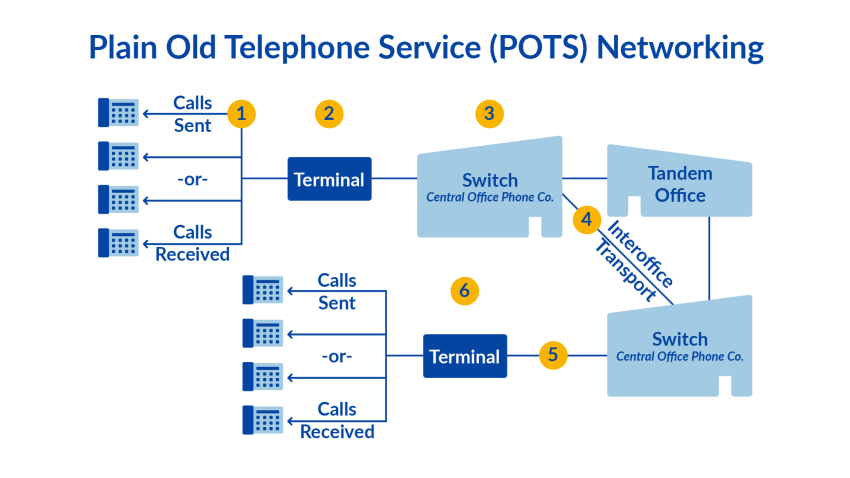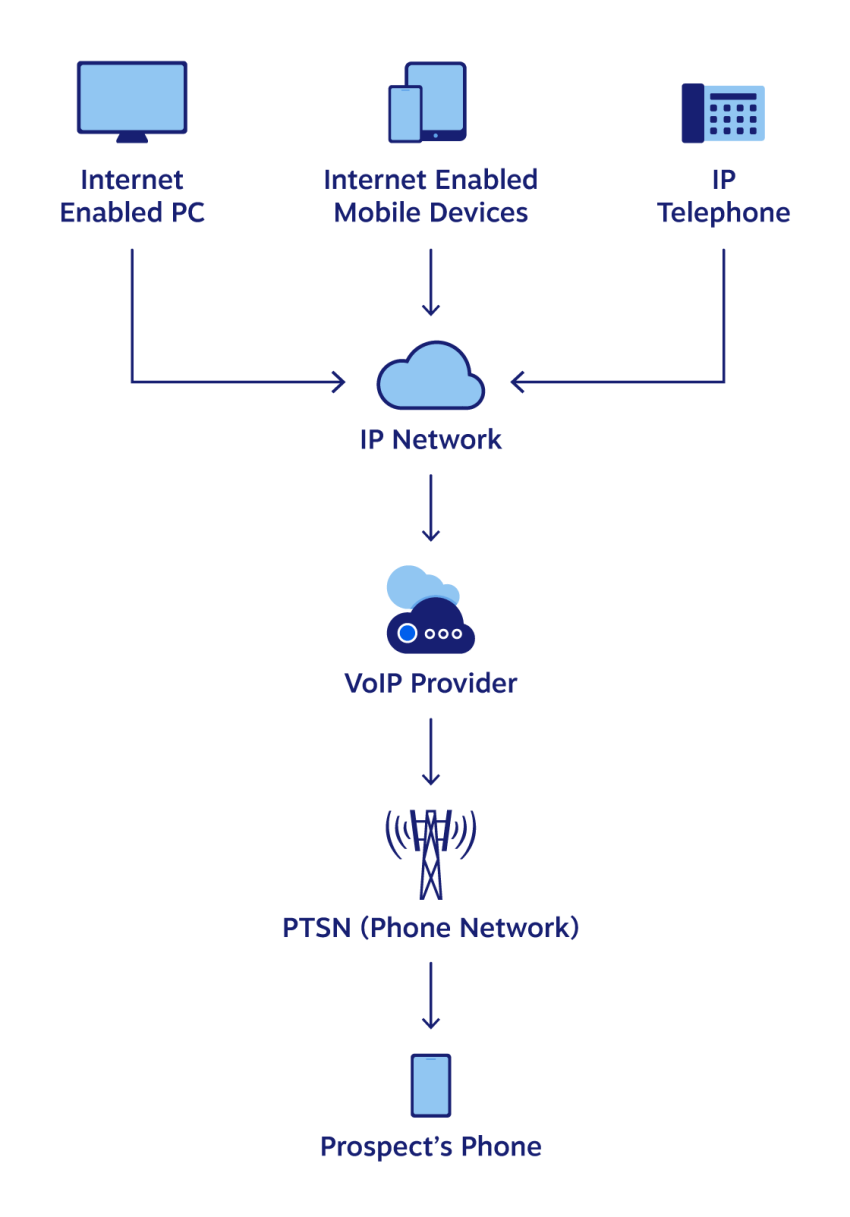Behind the simple ring of landline phones is a powerful, invisible network: the public switched telephone network (PSTN). For years, it transmitted voice calls over telephone lines, copper wires, and submarine cables.
Traces of its influence can still be felt today, even as internet connections and cloud-based communication tools become more commonplace. In this article, we’ll take a closer look at PSTN technology, its impact on global communications, and the technologies that have followed it.
What Is PSTN?
PSTN stands for public switched telephone network. It’s the traditional circuit-switched telephone network that has enabled real-time voice communication across the globe for over a century.
Commonly known as landlines, fixed lines, or Plain Old Telephone Service (POTS), the PSTN historically used phone lines, copper wires, and analog voice signals to connect telephones using standard phone numbers. It uses a dedicated physical connection for each call, ensuring consistent call quality.
While digital technologies like VoIP phone services are now prevalent, PSTN’s legacy and extensive infrastructure mean it continues to impact modern telecommunications, particularly in areas with limited internet connectivity.
Here’s an explanation of the PSTN, its history, and how it works:

A Brief History of PSTN
The public switched telephone network’s origins trace back to the late 19th century and the invention of the telephone by Alexander Graham Bell and Elisha Gray. Initially, these phones enabled simple point-to-point communication over copper wires.
The late 1800s and early 1900s saw the rise of manual switchboards, where operators physically connected calls. A significant shift occurred in the late 20th century with the introduction of automation, eliminating manual call handling and establishing the modern PSTN network.

Submarine cables and satellite communications further expanded international voice and data transmission. The 1970s and 80s brought digital technology to the PSTN, improving call quality and enabling data transmission.
Despite these advancements, the PSTN remained a relatively slow and limited technology, paving the way for the development of broadband and Voice over IP (VoIP) technology.
What Are the Key Characteristics of PSTN?
PSTN has several key characteristics:
1. Circuit-switching
Circuit-switching means two devices communicate via a dedicated, physical connection for the duration of the call. This contrasts with the packet-switching used by the internet, where voice data is broken into packets and sent over shared pathways. Circuit switching ensures consistent bandwidth and minimal latency, but it’s less efficient for data transmission.
2. Analog signals (historical basis)
The original PSTN infrastructure was built to transmit analog voice signals over copper wires. While digital channels are now integrated into many parts of the telephone system (e.g., digital switching in exchanges), the local loop (the connection to the customer’s premises) is often the last part of the network to be upgraded from analog to digital.
3. High reliability and resilience
The PSTN is known for high reliability and resilience. Its independent power source at central offices allows it to function even during local power outages, a key advantage in emergencies.
4. Extensive global reach (legacy infrastructure)
Historically, the PSTN provided near-universal global coverage, connecting households and businesses worldwide. While its dominance has declined with mobile and internet-based communications, its extensive infrastructure remains an advantage in many regions where cloud-based communication services aren’t available.
5. Limited bandwidth
Designed primarily for voice transmission, the PSTN offers limited bandwidth compared to modern digital networks. It’s unsuitable for high-bandwidth applications like video conferencing, high-definition streaming, or large data transfers.
6. POTS
The acronym POTS is used to refer to the PSTN, emphasizing its basic yet dependable functionality for real-time voice communication.
7. Fixed-line telephones
PSTN connections are typically connected to fixed locations. They’re based on physical telephone line connections between the telephone and the local exchange. This fixed nature distinguishes them from mobile cellular networks.
How PSTN Works Today
PSTN is a complex network encompassing telephone lines, fiber optic cables, switching centers, cellular networks, satellites, and cable systems.
Put simply, when you dial a phone number, your call moves through the network to reach its destination, and two phones connect. To fully understand how Plain Old Telephone Service works, consider what happens when you dial a number from your phone.
Here’s a simplified breakdown of how a call travels through the PSTN:
1. From a telephone handset to the central office
Your telephone converts your voice (sound waves) into electrical signals and transmits them over copper wires to a nearby local exchange. The terminal collects these signals and determines where your voice (converted into electrical signals) goes next.
2. Central office call routing
For long-distance calls, the central office may route the call through a fiber optic cable, which converts the electrical signals into light pulses for transmission. For local calls, the call is routed directly to the recipient’s local exchange.
3. From the central office to the terminating number
The relevant central office picks up the light pulses, converts them back into electrical signals, and sends them to the target terminal. The destination terminal forwards the call to the appropriate telephone number, and the recipient’s phone rings.
It takes a few seconds for your call to reach its destination via fiber optic cables and a global network of switches. It’s like changing buses to reach your final destination, only faster.
PSTN Architecture and Components
Historically, PSTN relied on manual switching, but modern networks are highly automated. Traditional PSTNs are a complex system with several key components working together:

Switching and the central office
PSTNs use switching systems to route telephone calls through the network. The central function is the local exchange, also called a central office or telephone exchange. Each local exchange can connect up to 10,000 subscriber telephones to the network. When a call is made, the switching system identifies the dialed number and establishes a dedicated wired connection between the caller and the recipient for the duration of the call.
Two higher-level switching systems that complement the local exchange are:
- Tandem office (junction network): Manages traffic between multiple local exchanges within a larger geographical area. If a caller in one suburb dials a number in another suburb of the same city, the tandem office routes the call between the respective local exchanges.
- Toll office: Responsible for national long-distance switching. All tandem offices link to toll offices, which manage inter-city or interstate call routing.
Transmission media (copper, fiber)
PSTNs traditionally use twisted-pair copper cables for voice transmission over short and medium distances. However, with the increasing demand for higher bandwidth and clearer signals, many networks have upgraded to fiber optic cables, particularly for trunk lines and inter-office connections. Fiber optic offers higher data capacity and lower signal degradation, which is more suitable for long-distance communications and high data volumes.
Customer premises equipment (CPE)
CPE includes all telecommunications equipment located on the subscriber’s premises. This ranges from analog or digital telephones, modems, and fax machines to PBX systems. Although these devices are connected to the public telephone network via the local loop, businesses own and manage them, not the service provider.
Trunking and gateways
Trunking is a system of high-performance communication lines, typically fiber optic or multiplexed copper, that carry all voice and data traffic between exchanges (local, tandem, and long-distance). Trunk lines are essential for carrying multiple telephone calls simultaneously and making optimal use of network resources.
Gateways are bridges between different network types. For example, a PSTN gateway connects traditional circuit-switched networks with IP-based networks such as VoIP. These gateways perform signal conversions and protocol translations to enable communication between different infrastructures.

How Much Does PSTN Access Cost?
How much would installing and using a PSTN phone system in your home or office cost you?
(Note: The following costs are estimates and can vary based on location and service provider.)
PSTN cost breakdown for home users
The PSTN system offers a reliable and straightforward solution for setting up a simple landline connection at home. Typical costs for residential customers are as follows:
| Basic setup cost | $60–$100 (includes telephone handset + service activation) |
| Monthly service fee | ~$30/month for unlimited local calls~$50/month for unlimited local + national calls |
| First month charges | $90–$110 total (handset + activation + first month) |
| Recurring costs | $30–$50/month, depending on the plan |
PSTN cost breakdown for businesses
For small and medium-sized businesses, the public telephone network provides reliable voice communications at scalable rates. The most important cost factors for office equipment are:
| Per-line monthly fee | $30–$60 per line (ideal for small businesses) |
| Installation & setup | $100–$200, depending on office size and infrastructure |
| Hardware cost | $50–$150 per desk phone/handset |
| Long-distance charges | Billed per minute, unless included in a bundled plan |
| Scalability costs | Additional charges apply when adding new lines or extensions |
Larger business solutions: KSU & PBX
For growing businesses, more advanced PSTN systems like KSU and PBX offer additional features and flexibility. Here’s an overview of the cost structure for each system:
| System | Key features | Best for | Estimated cost |
|---|---|---|---|
| Key system unit (KSU) for up to 40 employees | Multiple handsets, switching features, and limited internal call routing | Small-to-mid-sized businesses needing shared access and multiple features | $800 or more per line |
| Private branch exchange (PBX) for 40+ employees | Advanced features like call transfers, voicemail, auto attendants, call queues, and conferencing | Up to $4,000 for installation and setup $600–$2,000 monthly maintenance $10,000+ annual maintenance |
While PBX systems give businesses more control and features, they’re more expensive and might require internal or external IT support.
The Disadvantages and Decline of PSTN
While the public switched telephone network remains a globally recognized communication standard, its usage has steadily declined, especially in business settings. Statistics show a significant drop in landline subscriptions over the past decade, with mobile communication and internet-based solutions becoming prevalent.

Several factors drive this decline:
- Competition from VoIP services: VoIP phone systems offer lower costs, better flexibility, and IP telephony without traditional connections. Many users and businesses are therefore switching from PSTN services.
- Aging infrastructure: PSTN depends on old copper lines, which are expensive to maintain and upgrade. Compared to fiber optics, PSTN lines offer limited bandwidth and lower performance.
- Maintaining quality of service: PSTN was made for voice services, not for today’s high data traffic and multi-channel demands. Increasing congestion makes it difficult to ensure high voice quality.
The future of the PSTN depends on its ability to adapt and integrate newer technologies like VoIP and fiber.
PSTN Alternatives and Comparisons
PSTN’s limitations — outdated technology, costly infrastructure, and limited flexibility — make it logical to look for alternatives that address these shortcomings and offer improved functionality, scalability, and cost savings. Let’s look at a few key ones:
PSTN vs. ISDN
The Integrated Services Digital Network (ISDN) was introduced as a digital extension of the analog PSTN. It enabled better data transmission and provided multiple voice and data channels over a single line, which the PSTN didn’t support.

Although ISDN overcame many of the limitations of the PSTN with faster and more reliable digital connections, it’s now largely obsolete. High-speed internet and IP-based technologies like VoIP have surpassed ISDN in speed, flexibility, and cost.
PSTN is still based on circuit-switched analog lines with limited bandwidth and adaptability. ISDN, while advanced, was quickly overtaken by a more scalable, internet-based solution.
PSTN vs. PBX
PBXs work well for businesses that want to route internal and external telephone calls through a central switchboard. Traditional PBX systems are connected to external lines via the PSTN and are therefore still tied to the same analog infrastructure.
PBX technology offers more control and features than a simple PSTN connection, such as call forwarding and internal extensions. But expanding a traditional PBX system requires expensive hardware, rewiring, and ongoing maintenance.
Businesses are now turning to IP-based PBX systems or cloud communications platforms, which offer better scalability, lower costs, and easier integration of digital tools.

PSTN vs. VoIP
Voice over Internet Protocol (VoIP) is the successor to the traditional PSTN. The key difference is the technology behind them: VoIP converts voice into digital packets sent over the internet (packet switching), while PSTN uses analog electrical signals over dedicated copper lines (circuit switching). This difference offers VoIP business users many advantages in cost, features, and scalability.

For businesses, the financial benefits are enormous. The initial setup cost for a VoIP system is significantly lower than for a traditional PBX system connected to the PSTN. The savings continue with usage, as international calls over VoIP can be up to 60% cheaper.
The digital infrastructure of VoIP phone systems is inherently more flexible. They offer advanced features like CRM integration and voicemail-to-email, which are costly add-ons with PSTN. Scaling a VoIP phone service is possible with a simple software update, whereas expanding a PSTN network requires expensive new hardware and cabling.
The most important trade-off is reliability. PSTN is known for its stability and security through dedicated physical lines. VoIP, on the other hand, relies on a stable internet connection and power source for its operation.
| Feature | VoIP | PSTN |
|---|---|---|
| Connection type | Digital (Internet Protocol) | Analog (Copper Wires) |
| Monthly cost | $20–$40 per user | $30–$60 per user |
| Key advantage | Cost-effective, feature-rich, and highly scalable | Extremely stable and reliable connection |
| Main drawback | Requires internet and power to function | Expensive to install, maintain, and scale |
| Device support | Supports softphones, SIP phones, and analog phones via an adapter | Limited to basic, low-cost handsets |
While PSTN remains highly reliable, VoIP’s superior cost-effectiveness, advanced feature set, and effortless scalability make it the clear choice for most modern businesses.
What’s the Future of PSTN?
The PSTN continues to function in areas with limited access to newer technologies and for emergency calls. But its future is uncertain. It’s being phased out in favor of fiber optic and mobile networks.
PSTN’s limitations make it unsuitable for a growing business environment. The shift toward internet-based solutions such as VoIP and unified communications is accelerating, offering greater flexibility, cost efficiency, and functionality.

The future of PSTN is bleak. Companies will eventually need to adapt to newer technologies and business phone systems to stay relevant and offer better customer communications.
The Phone System Businesses Trust
The secret’s out. See why businesses ditched landlines for the cloud.
PSTN Frequently Asked Questions
Here’s what you need to know about PSTN.
While the PSTN is being phased out globally, remnants of it still exist in many areas. The complete shutdown is gradual, with different regions progressing at different speeds. So, in short, parts of it still exist, but its overall presence is diminishing.
The terms “PSTN” and “landline” are used interchangeably, but they aren’t the same. PSTN refers to the underlying network infrastructure — the physical wires, switches, and other equipment — that delivers traditional telephone service. A landline phone is the device that connects to this network. So, a landline uses the PSTN.
The PSTN is based on outdated, expensive analog technology to maintain and operate. It requires a vast network of physical infrastructure, including underground copper wires and dedicated switching centers. Modern VoIP technologies offer superior call quality, more features, and lower operational costs, making the transition and switch-off inevitable.
The primary replacement for PSTN is Voice over Internet Protocol (VoIP). VoIP transmits voice calls over the internet or other data networks, rather than through dedicated telephone lines. This allows for greater flexibility, integration with other digital communication methods, and often lower costs for users. Other technologies like smartphones, communication apps, and call centers are also replacing traditional landlines.

















 VoIP
VoIP 









